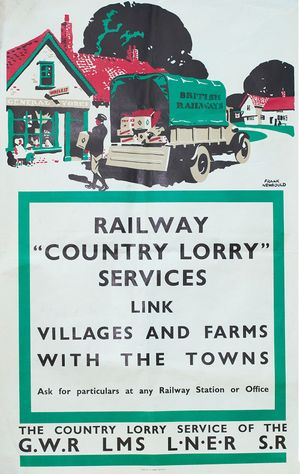Difference between revisions of "Country Lorry Service and Cartage Service"
(Another stub article and an attempt to expand and link together information on goods traffic.) |
(add poster) |
||
| Line 1: | Line 1: | ||
{{Stub}} | {{Stub}} | ||
| + | [[File:Country Lorry Service.jpg|thumb|300px|right|1935 poster]] | ||
As well as transporting goods station to station, the GWR was also able to collect & deliver goods and parcels to and from local addresses via its Country Lorry Service, Cartage Service or independent carrier. | As well as transporting goods station to station, the GWR was also able to collect & deliver goods and parcels to and from local addresses via its Country Lorry Service, Cartage Service or independent carrier. | ||
Revision as of 10:01, 15 May 2022
| |
As well as transporting goods station to station, the GWRGreat Western Railway was also able to collect & deliver goods and parcels to and from local addresses via its Country Lorry Service, Cartage Service or independent carrier.
A 1938 GWRGreat Western Railway publication, 'Towns villages, outlying works etc. served by the Great Western Railway' gives a list of all such places, their distance from the local station and the method of delivery.
The Country Lorry Service at Tenbury started on February 1 1931[1]
Several stations on the SVRSevern Valley Railway offered either a Lorry Service or Cartage Service, in some cases at no extra charge within a specified area.
See also
Station Truck Businesses located at SVR stations Private sidings connected to the Severn Valley Railway Collieries served by the Severn Valley Railway
